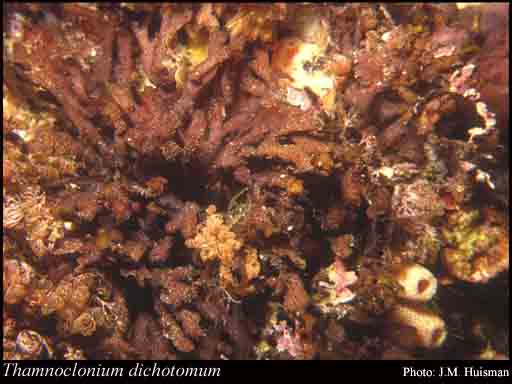- Reference
- Spec.Gen.Ord.Alg. 168 (1876)
- Conservation Code
- Not threatened
- Naturalised Status
- Native to Western Australia
- Name Status
- Current

Scientific Description
Habit and structure. Thallus dark brown-red, 10–30 cm high, cartilaginous, much branched irregularly to subdichotomously at intervals of (0.5–)1–4 cm, branches linear, terete to compressed, 1–3(–10) mm broad and 1.5–3 mm thick, covered throughout with short, irregularly branched excrescences and coated with a thin layer of sponge, often denuded near the base. Holdfast discoid-conical, 8–20 mm across; epilithic. Structure of a pseudoparenchymatous cortex 50–120 µm and 4–7 cells thick, outer cells rounded, more or less isodiametric, 6–10 µm across, inner cells subspherical, reaching 20–30 µm across; medulla of dense and compact filaments, 20–60 µm across; refractive ganglionic cells absent. Secondary cortex present on lower axes with a surface meristem developing vertical rows of cells and up to 18 growth rings. Rhodoplasts laminate, discoid to elongate, few per cell, becoming ribbon shaped and branched in inner cells.
Reproduction. Reproductive structures borne in small, fertile leaflets clustered at the apices and upper margins or sometimes laterally, 2–5(–8) mm long and 500–800 µm thick, irregularly lobed or flanged and smooth-surfaced (without sponge), and with a relatively lax filamentous medulla with some stellate cells. Sexual thalli dioecious. Carpogonial branch ampullae arising in inner cortex, with 3–6 erect secondary filaments each 2–8 cells long and a 2-celled carpogonial branch with a relatively robust trichogyne. Auxiliary cell ampullae in the inner cortex, with numerous secondary filaments of 4–8(–12) elongate cells and occasional tertiary filaments (pre-fertilization), slightly converging above in the outer cortex, filaments reaching to the outer cortex of elongate cells. Carposporophytes subspherical, compact, 120–200 µm across, usually crowded in the leaflets, with carposporangia ovoid to angular, 8–10 µm across; involucre prominent, developed by branching of the ampullary filaments; ostiole small. Spermatangia cut off from outer cortical cells, spermatia ovoid, 2–3 µm across. Tetrasporangia in nemathecia on fertile leaflets, cut off from subsurface cells but with the surface cells dividing to form filaments of 2–3 elongate cells, 20–30 µm long and 7–10 µm in diameter, cruciately divided.
Distribution. Nichol Bay, W. Aust., to Richmond River mouth, N.S.W., and around Tas.
[After Womersley, Mar. Benthic Fl. Southern Australia IIIA: 214–216 (1994)]
Distribution
- IBRA Regions
- Jarrah Forest, Swan Coastal Plain.
- IBRA Subregions
- Perth, Southern Jarrah Forest.
- IMCRA Regions
- Leeuwin-Naturaliste, WA South Coast.
- Local Government Areas (LGAs)
- Albany, Bunbury, Capel, Esperance, Mandurah.